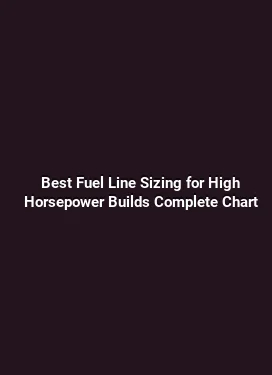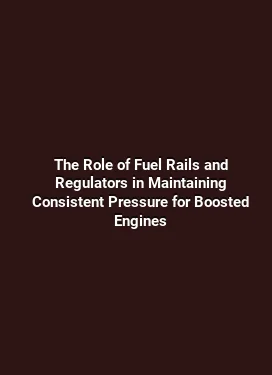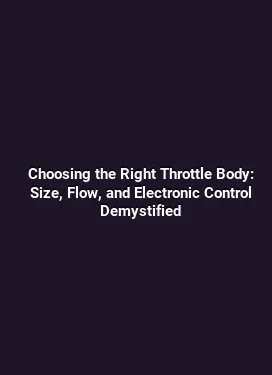Upgrading Your Fuel Pump: In-Tank vs External and Flow Rate Calculations
Fuel delivery is a foundational element of engine performance and reliability. When an upgrade is on the table, the choice often centers on whether to adopt an in-tank pump assembly or a high-capacity external pump. Both configurations have distinct advantages and trade-offs, influenced by engine aspirations, fuel pressure requirements, and the overall fuel system architecture. This article delves into the mechanics of fuel pumps, compares in-tank and external options, and provides practical methods for calculating flow rate needs that align with tuning goals, driving conditions, and fuel economy considerations.
Understanding the Fuel System’s Core Roles

A modern fuel system is more than a single pump and line. It encompasses the pump, reservoir, lines, filters, pressure regulators, and the return path in some setups. The pump’s primary job is to deliver a consistent volume of fuel at the correct pressure to the fuel rail, where injectors atomize it into the combustion chamber. Any disparity in pressure or flow manifests as misfires, reduced power, or poor drivability at certain RPM ranges. In high-performance builds, the demands increase as volumetric efficiency rises and the engine experiences more aggressive fueling curves.
Two critical measurements guide upgrades: flow rate (how much fuel is delivered per unit time) and fuel pressure (how hard the pump pushes fuel toward the engine). In practice, increasing power output typically requires both a pump capable of higher flow and a regulator system that maintains stable pressure across a broad RPM band. With that foundation, the discussion moves to the two primary pump configurations: in-tank and external.
In-Tank Pumps: Quiet, Efficient, and Integrated
In-tank pumps are mounted inside the fuel tank itself. This placement provides several advantages: improved cooling due to contact with the liquid, reduced vibrations, and often quieter operation. Modern vehicles often use a multi-pump assembly housed in a shared reservoir, which allows for separate feed lines for different fuel pressure demands or even integrated filters and pre-filters. For many street and mildly tuned applications, an upgraded in-tank pump preserves stock-like drivability while enhancing reliability under higher fuel demands.
Key considerations when selecting an in-tank pump include compatibility with the existing delivery line diameter, the ability to deliver peak flow at the engine’s required pressure, and the infrastructure for mounting, filtration, and return management. Some in-tank designs feature a built-in regulator or a dedicated return line for sensitive engines, though many modern setups employ returnless configurations to simplify the system and reduce heat transfer from the engine bay to the fuel. An essential aspect is ensuring the pump’s electrical characteristics—voltage, current draw, and impedance—match the vehicle’s wiring harness and the engine control strategies in use.
Advantages of In-Tank Upgrades

In-tank pumps usually offer better cooling while running, less fuel aeration, and lower noise levels. They can deliver steady pressure with less pulsation, particularly when paired with a dampened filter and properly sized hoses. For engines that remain within stock fuel pressure targets or push moderate horsepower gains, in-tank upgrades often provide a reliable, user-friendly path to improved fueling without drastic system redesigns.
Limitations and Practical Tips
One notable limitation is the potential for access and installation complexity. Access panels, tank removal, and the risk of fuel contamination during service require careful procedure and adequate safety measures. When upgrading an in-tank pump, it’s essential to verify the pump’s compatibility with the vehicle’s fuel system: inlet size, outlet size, and the presence or absence of return lines. A common pitfall is neglecting the impedance of the assembly, which can affect fuel pressure stability at high RPM. Additionally, ensure that the chosen pump can sustain the required volume at the engine’s target pressure across the entire RPM range, not just at idle or peak load.
External Pumps: High-Flow Capabilities and Flexible Mounting
External fuel systems place the pump outside the fuel tank, often in the trunk or undercarriage, connected to a separate reservoir. This arrangement provides exceptional flexibility for high-horsepower builds, where ultra-high flow rates are necessary to maintain stable pressure at sustained high RPMs. External pumps are advantageous when the fuel demand outgrows the capacity of an in-tank unit or when a single pump must serve multiple injectors over an extended line. They also enable easier serviceability, as the pump can be accessed without dropping the tank in many configurations.
Critical aspects for external pumping include the selection of compatible lines, obsessive attention to hose routing to prevent vapor lock or heat soak from the exhaust, and the use of an external reservoir or surge tank to minimize fuel pressure fluctuations during rapid throttle changes. The external route typically requires an inline pump paired with a pressure regulator positioned near the rail or integrated into the return path. This configuration often demands AWD or heavy-duty wiring and an appropriately rated power supply to avoid voltage drop under load.
High-Flow Considerations and Step-By-Step Upgrades
For extreme horsepower targets, a staged approach works well: begin with a robust in-tank pump that exceeds the stock flow while ensuring compatibility with the factory regulator and filter. If further gains are needed, introduce an external pump with a low-restriction feed line and a regulator tuned for the engine’s dynamic fueling needs. Surge protection and return line management become critical as flow increases; installing a surge tank close to the rail minimizes pressure dips during rapid throttle transitions. Check for compatibility with fuel filter rating and the pump’s duty cycle to avoid overheating during long pulls or sustained high-load events.
Flow Rate Calculations: How to Size a Pump for Your Build
Flow rate calculations are not just a matter of selecting a pump with a higher number on the box. They require understanding the engine’s fueling demands across the operating range, the regulator behavior, and the injectors’ capacity. The core objective is to maintain adequate pressure at the rail during the engine’s most demanding conditions while ensuring the injector flow remains well within its optimum window for atomization and response.
The first step is to determine the engine’s peak fuel flow requirement. This is often derived from the horsepower target and the brake specific fuel consumption (BSFC) around the engine’s peak torque region. A common approximation uses the equation: fuel flow (gph) ≈ (engine horsepower) × (BSFC) × (fuel density adjustments) / efficiency factor. Practically, many tuners convert horsepower to liters-per-hour of fuel delivery, adjusting for units and system losses. It’s important to review the injector size, as injectors set the upper bound on how much fuel can be delivered at a given duty cycle. If the injector flow rate is insufficient to meet the target, upgrading injectors in tandem with the pump is often necessary.
Pressure consistency across RPM is another critical metric. A higher flow pump must be able to maintain target rail pressure without excessive droop. The fuel pressure regulator (whether integrated or external) should be sized to respond quickly to load changes and not introduce oscillations. In practical terms, you’ll measure rail pressure at various RPM and load states, then compare to the regulator’s range. If pressure droop occurs at high RPM, you may need a pump with higher head (pressure capacity) or a regulator with faster response and larger flow capability. In contrast, excessive pressure can stress injectors and mapping; thus, tuned pressure targets are essential for reliable operation.
Practical Tips for Accurate Sizing
1) Start from the horsepower target and desired fuel efficiency, then map the predicted BSFC across RPM bands to estimate total fuel volume needed. 2) Ensure injector flow aligns with the pump’s operating window at the intended pressure. 3) Consider the system’s total dynamic resistance, including hoses, filters, and fittings, as these contribute to pressure drop. 4) Use a fuel pressure gauge or an aftermarket rail sensor to identify pressure stability and characterize how the system responds during boost or high-load events. 5) When in doubt, plan for a buffer: selecting a pump with 15–25% higher peak flow than the calculated requirement can accommodate unexpected conditions without compromising rail pressure.
Integrating the Right Components: Regulators, Filters, and Wiring
A high-performance fueling system is more than the pump alone. The regulator, filter, and wiring harness all contribute to consistent delivery. The regulator sets the rail pressure. In high-demand setups, a regulated return system can help dissipate excess pressure and prevent overheating. Filters must be rated for the chosen flow and particle size to avoid clogging injectors at high flow. Wiring should be sized for the pump’s amperage and include proper grounding to prevent voltage sag during cranking or boost events. A well-matched system minimizes heat soak, reduces noise, and delivers predictable fueling across cruising, acceleration, and full-load scenarios.
Return vs Returnless Configurations
Returnless designs simplify the system by routing unused fuel back to the tank via the regulator, reducing heat transfer to the fuel and simplifying the plumbing. However, some high-boost setups benefit from a return line to prevent pump starvation during rapid throttle changes. The decision hinges on the engine’s fueling profile, the chosen regulator’s behavior, and the fuel’s temperature characteristics in the specific vehicle environment. Both approaches require careful attention to pump compatibility and electrical demands to avoid performance droop during demanding driving scenarios.
Practical Scenarios: Real-World Upgrades and What to Expect
Consider a naturally aspirated or mildly boosted engine targeting a modest horsepower increase. An upgraded in-tank pump, paired with a matched regulator and quality filter, can deliver improved reliability without introducing complexity in the fuel system. For a turbocharged or supercharged setup pushing significant horsepower, an external high-flow pump with an appropriately rated regulator and properly routed lines often yields the best balance between maintaining rail pressure and delivering volume under boost. In either case, the upgrade should be accompanied by a comprehensive diagnostic plan: check for fuel trim stability, monitor rail pressure across rpm bands, verify injector duty cycles stay within safe limits, and assess fuel temperatures under varying ambient conditions.
Common Pitfalls and How to Avoid Them
Skipping a proper separator or pre-filter can allow debris to reach injectors, causing erratic spray patterns. Undersized lines or restrictive fittings create a bottleneck that undermines the pump’s capability. Inadequate wiring or poor grounding can lead to voltage drops that fade performance at critical moments. Finally, failing to coordinate the upgrade with calibration changes in the engine management system can leave fueling maps out of sync, producing rich or lean conditions under load. A disciplined approach—planning, measurement, and staged testing—helps avoid these issues and ensures the upgrade delivers predictable gains without compromising driveability.
Testing and Validation: Ensuring the Upgrade Delivers
After installation, a structured testing sequence confirms the upgrade’s effectiveness. Begin with static checks: verify rail pressure at idle, then perform a controlled load test to observe how pressure behaves as engine load increases. A data-logging setup helps track fuel pressure, injector duty cycle, and related temperatures. A road test across varied conditions—idle, city driving, highway cruising, and full-throttle acceleration—reveals how the system responds in real-world scenarios. If discrepancies appear, revisit the regulator setting, line routing, and pump compatibility with the engine’s fueling profile. The goal is to achieve a smooth fueling curve with minimal pressure fluctuation, stable injectors, and consistent performance across RPM and load profiles.
Maintenance Considerations for Longevity
Routine checks include inspecting the fuel filter, monitoring for signs of pump noise, and ensuring electrical connections remain tight and free of corrosion. In-tank systems demand attention to the tank’s environment; avoid contamination during service and follow best practices for handling fuel. External systems require examining hose clamps and fittings for leaks, as well as ensuring heat management is adequate to prevent vapor formation that could undermine pressure stability. A proactive maintenance schedule helps preserve performance gains and reduces the likelihood of drivability issues arising from fuel system wear.
Summary of Key Concepts for a Balanced Upgrade Plan
Choosing between in-tank and external pumps hinges on the engine’s demand curve, the fuel system layout, and the tolerance for installation complexity. Flow rate calculations should drive the decision, ensuring that both peak flow and regulator stability align with the engine’s fueling strategy. The integration of compatible regulators, filters, and electrical systems completes the equation, enabling a reliable, high-performance fueling solution for a broad range of vehicles and use cases. The ultimate result is a system that delivers consistent fuel pressure, maintains injector performance, and supports the intended power and drive characteristics without compromising daily usability.






